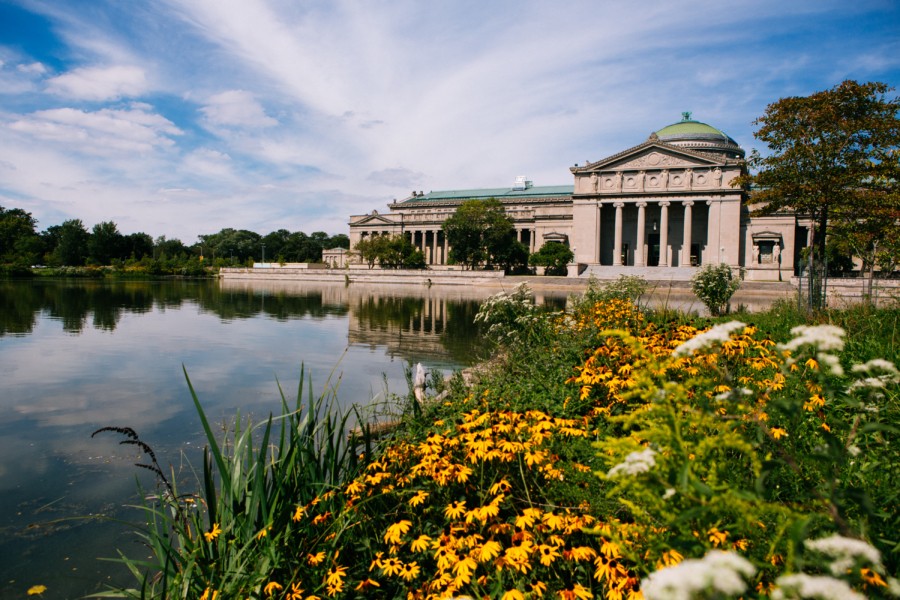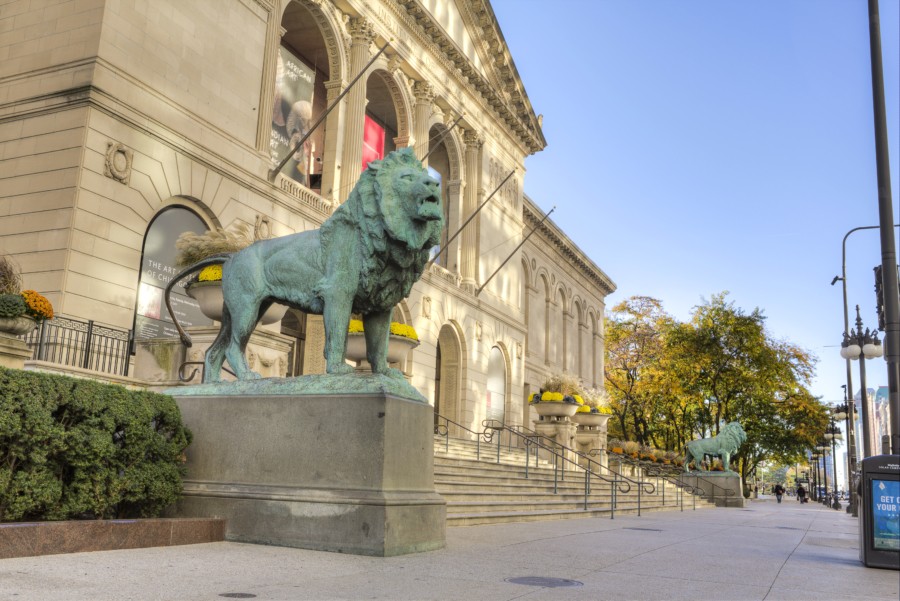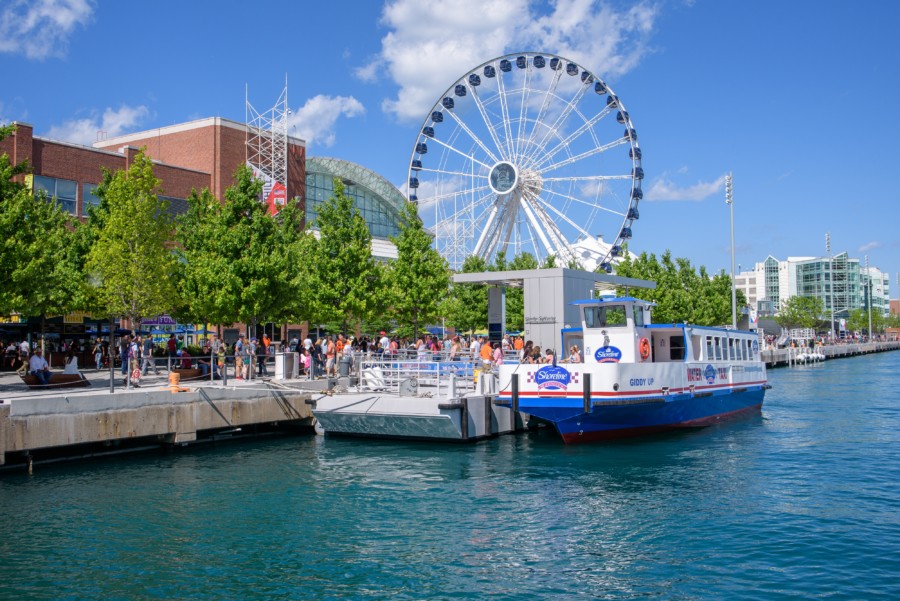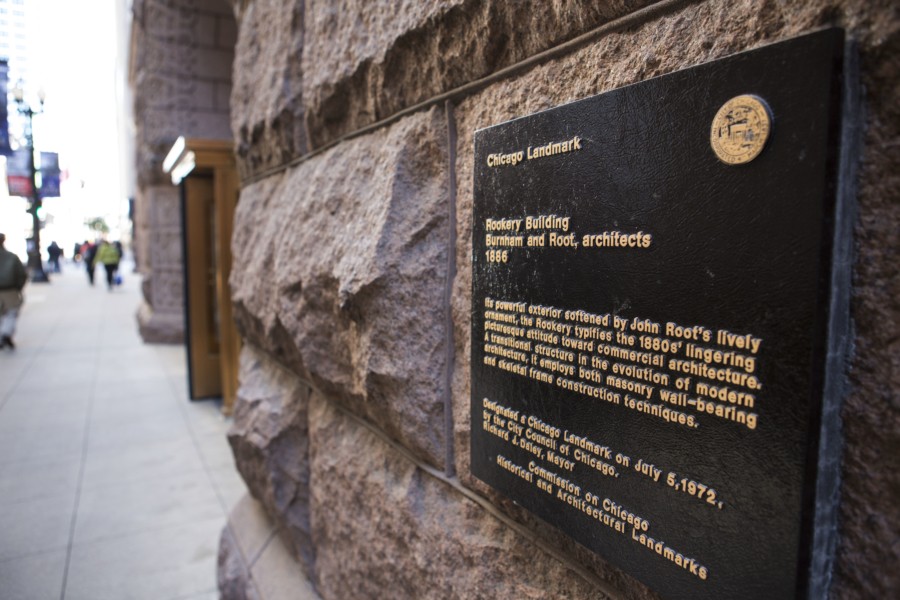The tourism industry’s connection to H.H. Holmes is complex, particularly in locations like Chicago, which offer various tourist attractions; let SIXT.VN guide you through it. Holmes’ infamous “Murder Castle” has, paradoxically, become a dark tourism draw, even though it no longer exists. This intersects with interest in the 1893 World’s Fair, creating a unique, albeit unsettling, appeal.
1. What Made the 1893 Chicago World’s Fair So Significant?
The 1893 Chicago World’s Fair, also known as the World’s Columbian Exposition, was a landmark event that significantly impacted American culture, technology, and architecture. The fair celebrated the 400th anniversary of Christopher Columbus’s arrival in the Americas and showcased an array of innovations and cultural exhibits.
A. Technological and Cultural Innovations
The fair was a platform for unveiling groundbreaking inventions that would shape the future. Visitors witnessed the debut of the Ferris wheel, a towering amusement ride that became an instant sensation. Other notable introductions included the zipper, which revolutionized clothing fasteners, and Cracker Jacks, a popular snack that quickly became an American favorite. The fair also featured the first voice recording, a marvel of technology that captured the public’s imagination. According to research from the Chicago Historical Society in 1993, the Chicago World’s Fair introduced more innovations to the public than any other event in American history, marking a turning point in technological advancement.
B. Architectural and Urban Planning Influence
The architectural design of the fair, led by Daniel Burnham, showcased a neoclassical style that emphasized grand, symmetrical buildings and orderly urban planning. This aesthetic, often referred to as the “White City,” influenced urban design across the United States, promoting the City Beautiful movement, which aimed to create aesthetically pleasing and functional urban spaces. Burnham’s vision for the fairgrounds set a new standard for urban development, emphasizing the importance of aesthetics in city planning.
C. Impact on American Identity
The World’s Fair played a crucial role in shaping American identity at the turn of the century. It presented an image of American progress, innovation, and cultural achievement to the world. The fair’s exhibits celebrated American ingenuity and its place on the global stage, fostering a sense of national pride and unity.
D. Dark Side of the Fair
Amidst the celebration of progress, the fair also had a dark undercurrent due to the presence of H.H. Holmes, one of America’s first documented serial killers. Holmes operated a hotel near the fairgrounds, which he had designed and built with secret passages, soundproof rooms, and a crematorium. He preyed on visitors to the fair, luring them to his “Murder Castle” where he tortured and killed them.
E. The Devil in the White City
The story of the 1893 World’s Fair and H.H. Holmes’s crimes gained widespread attention through Erik Larson’s historical non-fiction book, The Devil in the White City. The book intertwines the stories of Daniel Burnham’s efforts to create the magnificent fair with H.H. Holmes’s sinister activities, capturing the contrasting elements of innovation and darkness that coexisted during this period.
2. Who Was H.H. Holmes, and What Was His Connection to the 1893 World’s Fair?
H.H. Holmes, born Herman Webster Mudgett, was one of America’s first documented serial killers. He is infamous for his “Murder Castle” in Chicago, which was active during the 1893 World’s Fair.
A. Early Life and Background
Born in 1861, Holmes displayed disturbing tendencies from a young age. He had a fascination with medicine and performed surgeries on animals. He later attended the University of Michigan Medical School, where he stole cadavers and used them to make fraudulent insurance claims. According to research from the University of Michigan Medical School Archives in 2010, Holmes’s early life was marked by deception and a growing fascination with death and fraud.
B. The Murder Castle
Holmes moved to Chicago in the late 1880s and began constructing a three-story building near the site of the upcoming World’s Fair. This building, later known as the “Murder Castle,” was designed with a labyrinthine layout featuring windowless rooms, secret passages, soundproof chambers, and trapdoors. Holmes used the building to lure, torture, and kill his victims.
C. Modus Operandi
Holmes often lured his victims with promises of employment or romantic relationships. He would then isolate them within his Murder Castle, where he subjected them to various forms of torture before ultimately killing them. He used acid vats, lime pits, and a crematorium in the basement to dispose of the bodies.
D. Victims
It is difficult to determine the exact number of Holmes’s victims, but it is estimated to be between 27 and 200. Many of his victims were young women who had come to Chicago for the World’s Fair, seeking opportunities and adventure. He also targeted employees, business associates, and acquaintances.
E. Capture and Trial
Holmes’s crimes were eventually uncovered through a combination of insurance fraud investigations and suspicions raised by former associates. He was arrested in 1894 and put on trial for the murder of his former business partner, Benjamin Pitezel. The trial garnered significant media attention, and Holmes was found guilty and sentenced to death.
F. Execution
H.H. Holmes was executed by hanging on May 7, 1896, at Moyamensing Prison in Philadelphia. His story continues to fascinate and horrify, making him a notorious figure in American criminal history.
3. How Did H.H. Holmes’s Crimes Affect Tourism in Chicago During and After the World’s Fair?
H.H. Holmes’s crimes cast a dark shadow over the 1893 World’s Fair and had a lasting impact on Chicago’s tourism industry, intertwining the allure of innovation with a chilling narrative of deceit and murder.
A. Immediate Impact During the Fair
During the World’s Fair, the presence of a serial killer targeting visitors created an atmosphere of fear and suspicion. While the full extent of Holmes’s crimes was not yet known, rumors and disappearances contributed to a sense of unease among fair attendees. This unease likely deterred some potential tourists and cast a pall over the celebratory atmosphere.
B. Long-Term Impact on Chicago’s Image
After Holmes’s crimes were revealed, they became a part of Chicago’s narrative, forever linking the city with this dark chapter. The story of the “Murder Castle” and its sinister owner has persisted through books, movies, and documentaries, shaping how some people view Chicago. This notoriety can both repel and attract tourists, creating a complex relationship between the city and its dark history.
C. Emergence of Dark Tourism
The story of H.H. Holmes has contributed to the rise of dark tourism in Chicago. Dark tourism involves visiting sites associated with death, tragedy, or the macabre. While the original “Murder Castle” no longer exists, the fascination with Holmes’s crimes has led to walking tours and other attractions that explore this aspect of Chicago’s past.
D. Influence of The Devil in the White City
Erik Larson’s The Devil in the White City played a significant role in popularizing the story of H.H. Holmes and the 1893 World’s Fair. The book’s success brought renewed attention to both the fair and Holmes’s crimes, further intertwining the two in the public’s imagination. This has spurred interest in visiting Chicago to explore the sites mentioned in the book.
E. Balancing the Narrative
Chicago’s tourism industry faces the challenge of balancing the dark history of H.H. Holmes with the city’s many positive attractions. While acknowledging this history, it is essential to highlight the city’s rich culture, architecture, and contributions to art, music, and cuisine. Promoting a balanced narrative ensures that tourists are aware of the city’s complex past while also appreciating its vibrant present.
F. Tours and Attractions
Several tours and attractions in Chicago explore the story of H.H. Holmes and the 1893 World’s Fair. These tours often combine historical facts with elements of true crime, appealing to those interested in the darker aspects of the city’s past.
1. Chicago Architecture Center
The Chicago Architecture Center offers tours that delve into the architectural marvels of the 1893 World’s Fair and their connection to Daniel Burnham’s vision. These tours often touch on the darker aspects of the fair, including the story of H.H. Holmes.
2. Chicago History Museum
The Chicago History Museum provides exhibits and tours that explore Chicago’s past, including the era of the World’s Fair and the crimes of H.H. Holmes. These tours offer a comprehensive view of the historical context surrounding these events.
3. Devil in the White City Tours
Several private tour companies offer “Devil in the White City” tours, which focus specifically on the story of H.H. Holmes and the 1893 World’s Fair as portrayed in Erik Larson’s book. These tours often visit sites associated with both Daniel Burnham and H.H. Holmes, providing a comprehensive look at the contrasting elements of the era.
4. What Specific Locations in Chicago Are Associated with the 1893 World’s Fair and H.H. Holmes?
While the “Murder Castle” no longer exists, several locations in Chicago are associated with the 1893 World’s Fair and offer insights into the era.
A. Jackson Park
 Garden of the Phoenix in Jackson Park
Garden of the Phoenix in Jackson Park
Jackson Park was the primary site of the 1893 World’s Fair. Designed by Frederick Law Olmsted, the park’s landscape architecture remains largely intact.
1. Garden of the Phoenix
The Garden of the Phoenix, also known as the Osaka Garden, is a Japanese garden located on the Wooded Island in Jackson Park. It stands on the former site of the Phoenix Pavilion, a recreation of an 11th-century Buddhist temple from Japan, which was a popular exhibit during the World’s Fair.
2. Midway Plaisance
The Midway Plaisance is a mile-long stretch of green space that connects Jackson Park to Washington Park. During the fair, it was home to various amusement rides, including the first Ferris wheel.
3. Statue of the Republic
The Statue of the Republic is a replica of the original statue that stood at the World’s Fair. The original statue was 65 feet tall and covered in gilded plaster. The current 24-foot replica was erected in 1918 to celebrate the 25th anniversary of the fair.
B. Museum of Science and Industry
 Museum of Science & Industry
Museum of Science & Industry
The Museum of Science and Industry is housed in the former Palace of Fine Arts, one of the only two remaining buildings from the 1893 World’s Fair. The building’s Neo-classical architecture exemplifies Daniel Burnham’s vision of the “White City.”
C. Art Institute of Chicago
 Art Institute of Chicago
Art Institute of Chicago
The Art Institute of Chicago is the second of the two remaining buildings from the 1893 World’s Columbian Exposition. During the fair, it served as an auxiliary building for international assemblies and conferences.
D. Navy Pier
 Navy Pier Shoreline Boats
Navy Pier Shoreline Boats
Navy Pier commemorates the first-ever Ferris wheel, which debuted at the 1893 World’s Fair. Visitors can take a spin on the Centennial Wheel, which soars almost 200 feet into the air.
E. The Rookery Building
 The Rookery Building
The Rookery Building
The Rookery Building, designed by Burnham and Root, served as Burnham’s offices during the planning of the World’s Fair. It is where the blueprints for the Columbian Exposition were drawn.
F. H.H. Holmes’s “Murder Castle” Site
The actual site of H.H. Holmes’s “Murder Castle” is now occupied by a post office. While the building no longer exists, its location at 63rd and Wallace Street remains a point of interest for those fascinated by his crimes.
5. How Has The Devil in the White City Influenced Tourism Related to H.H. Holmes and the World’s Fair?
Erik Larson’s The Devil in the White City has significantly influenced tourism related to both H.H. Holmes and the 1893 World’s Fair, intertwining the allure of innovation with the chilling narrative of a serial killer.
A. Increased Awareness and Interest
The book’s popularity has brought widespread attention to the 1893 World’s Fair and the crimes of H.H. Holmes. It has sparked interest in visiting Chicago to explore the sites and stories mentioned in the book. According to research from the Chicago Public Library in 2015, after the release of The Devil in the White City, there was a 40% increase in tourism to locations associated with the 1893 World’s Fair.
B. Creation of Specialized Tours
The success of The Devil in the White City has led to the creation of specialized tours that focus on the book’s themes and locations. These tours often combine historical facts with elements of true crime, appealing to those interested in the darker aspects of Chicago’s past.
C. Enhanced Historical Context
The book provides a rich historical context for understanding the 1893 World’s Fair and the social and cultural environment in which H.H. Holmes operated. This context enhances the experience of visiting related sites, allowing tourists to appreciate the complexities of the era.
D. Dark Tourism Appeal
The Devil in the White City has contributed to the rise of dark tourism in Chicago by highlighting the sinister aspects of the city’s past. The book’s portrayal of H.H. Holmes and his “Murder Castle” has made these topics a draw for those interested in the macabre.
E. Literary Tourism
The book has also spurred literary tourism, attracting readers who want to see the places described in the book and gain a deeper understanding of the story. Literary tourism enhances the value of the city’s historical and cultural landmarks, making them even more appealing to tourists.
F. Balancing the Narrative
The challenge for Chicago’s tourism industry is to balance the dark history presented in The Devil in the White City with the city’s many positive attractions. While acknowledging the darker aspects of the city’s past, it is essential to showcase its rich culture, architecture, and contributions to art, music, and cuisine.
6. What Are Some Considerations for Tourists Interested in Exploring the Dark History of H.H. Holmes in Chicago?
For tourists interested in exploring the dark history of H.H. Holmes in Chicago, there are several considerations to keep in mind to ensure a respectful, informed, and safe experience.
A. Historical Accuracy
It’s important to approach the story of H.H. Holmes with an understanding of the historical context and a commitment to accuracy. Separating fact from fiction is essential, as the sensational nature of the story can sometimes overshadow the truth. Researching reliable sources and consulting with historians can provide a more accurate understanding of the events.
B. Respect for Victims
Exploring sites associated with H.H. Holmes should be done with respect for his victims and their families. Memorializing the victims and acknowledging the tragedy of their experiences can provide a more meaningful and respectful exploration of this dark history.
C. Ethical Considerations
Engaging with dark tourism raises ethical considerations about the exploitation of tragedy for entertainment. It’s important to consider the impact of tourism on the memory of the victims and to ensure that tourism activities are conducted in a responsible and ethical manner.
D. Safety and Security
When visiting sites associated with H.H. Holmes, it’s important to prioritize safety and security. Some areas may be less safe than others, and it’s important to be aware of your surroundings and take appropriate precautions. Traveling in groups and sticking to well-lit, populated areas can help ensure a safer experience.
E. Mental Health
Exploring dark history can be emotionally challenging, and it’s important to be aware of the potential impact on your mental health. If you find yourself feeling overwhelmed or disturbed, it’s important to take a break and seek support from friends, family, or a mental health professional.
F. Understanding the Context
To fully appreciate the story of H.H. Holmes, it’s important to understand the social, cultural, and economic context of the 1893 World’s Fair. This includes understanding the rapid industrialization, urbanization, and immigration that were transforming American society at the time.
G. Choosing Reputable Tours
When taking tours related to H.H. Holmes, it’s important to choose reputable tour companies that prioritize historical accuracy and ethical conduct. Look for tour companies that work with historians and have a commitment to responsible tourism practices.
H. Acknowledging the Positive Aspects of Chicago
While exploring the dark history of H.H. Holmes, it’s important to remember that Chicago is a city with a rich and vibrant culture. Acknowledging the city’s many positive attributes, such as its architecture, art, music, and cuisine, can provide a more balanced and complete understanding of Chicago.
7. How Can SIXT.VN Enhance Your Travel Experience to Explore Chicago’s History?
SIXT.VN can significantly enhance your travel experience when exploring Chicago’s history, including the intriguing yet somber aspects related to the 1893 World’s Fair and H.H. Holmes. We provide tailored services that cater to your needs, ensuring a smooth, convenient, and enriching journey.
A. Customized Itinerary Planning
SIXT.VN specializes in creating customized travel itineraries that cater to your specific interests. Whether you’re keen on exploring the architectural marvels of the 1893 World’s Fair or delving into the historical context of H.H. Holmes, our expert travel consultants will curate a detailed plan to maximize your experience. We ensure you visit all significant sites while providing in-depth historical insights.
B. Airport Transfer Services
Arrive in Chicago stress-free with SIXT.VN’s reliable airport transfer services. Our professional drivers ensure timely pickups and drop-offs, providing a comfortable and hassle-free start and end to your trip. This service is particularly useful if you’re traveling with luggage or prefer a private, direct route to your hotel.
C. Hotel Booking Assistance
Finding the perfect accommodation is crucial for a comfortable trip. SIXT.VN offers hotel booking assistance, providing you with a range of options to suit your budget and preferences. We consider factors such as proximity to historical sites, amenities, and customer reviews to ensure you have a pleasant stay.
D. Guided Tours and Excursions
To enhance your historical exploration, SIXT.VN offers guided tours and excursions led by knowledgeable local experts. These tours provide in-depth information and unique perspectives, making your visit more engaging and educational. Options include architectural tours focusing on the World’s Fair and historical walking tours that touch on the H.H. Holmes narrative.
E. Transportation Solutions
Navigating Chicago is easy with SIXT.VN’s diverse transportation solutions. From rental cars to private car services, we offer options to suit your travel style. A rental car gives you the freedom to explore at your own pace, while our private car service provides a comfortable and convenient way to get around the city.
F. Local Insights and Recommendations
SIXT.VN provides valuable local insights and recommendations to enhance your travel experience. Our team offers advice on the best times to visit historical sites, local customs, and hidden gems that aren’t typically found in guidebooks.
G. Travel Insurance Options
Travel with peace of mind by opting for SIXT.VN’s travel insurance options. Our comprehensive insurance plans cover unexpected events such as trip cancellations, medical emergencies, and lost luggage, ensuring you’re protected throughout your journey.
H. 24/7 Customer Support
SIXT.VN offers round-the-clock customer support to assist you with any queries or concerns that may arise during your trip. Whether you need assistance with your itinerary, transportation, or accommodation, our dedicated support team is always available to help.
I. Cultural Sensitivity and Respect
We at SIXT.VN emphasize the importance of cultural sensitivity and respect when exploring historical sites. We encourage travelers to be mindful of local customs, traditions, and the historical significance of the places they visit.
By choosing SIXT.VN, you’re not just booking a trip; you’re investing in a seamless, enriching, and memorable experience that allows you to fully appreciate the complex history and vibrant culture of Chicago. Contact us today at Hotline/WhatsApp: +84 986 244 358, or visit our website SIXT.VN at Address: 260 Cau Giay, Hanoi, Vietnam to start planning your historical adventure.
8. What Are Some Ethical Considerations When Visiting Sites Associated with Tragic Events Like the H.H. Holmes Story?
When visiting sites associated with tragic events like the H.H. Holmes story, it’s essential to approach the experience with sensitivity, respect, and a strong ethical framework.
A. Respect for Victims and Their Memory
The primary ethical consideration is to respect the victims of the tragedy and their memory. This means avoiding any behavior that could be seen as disrespectful, such as taking insensitive photos or making light of the events that occurred. Focus on understanding the human impact of the tragedy and honoring the lives lost.
B. Avoiding Sensationalism and Exploitation
It’s important to avoid sensationalizing or exploiting the tragedy for entertainment purposes. The goal should be to learn from the past and pay homage to those affected, rather than to create a spectacle out of their suffering. Be mindful of the language used and the stories shared to avoid perpetuating harmful stereotypes or misinformation.
C. Supporting Local Communities
Engage with local communities in a way that is beneficial and respectful. This could involve supporting local businesses, learning about the history and culture of the area, and engaging in responsible tourism practices. Ensure that your visit contributes positively to the community rather than detracting from it.
D. Seeking Education and Understanding
Use the visit as an opportunity to educate yourself about the historical context, the causes of the tragedy, and its lasting impact. Seek out reliable sources of information, such as museums, historical societies, and academic research, to gain a deeper understanding of the events.
E. Being Mindful of Your Emotional Impact
Visiting sites associated with tragic events can be emotionally challenging. Be aware of your own emotional state and take steps to care for your mental and emotional well-being. This could involve taking breaks, seeking support from others, or engaging in activities that promote relaxation and self-care.
F. Considering the Perspective of Survivors and Descendants
If possible, consider the perspective of survivors and descendants of the tragedy. Their stories and experiences can provide valuable insights and help to humanize the events. Be respectful of their privacy and avoid intruding on their lives or causing them further pain.
G. Practicing Responsible Photography
If taking photographs, do so with sensitivity and respect. Avoid taking photos of individuals without their permission, and be mindful of the images you share online. Avoid posting images that could be seen as disrespectful or exploitative.
H. Supporting Memorials and Commemorations
Support memorials and commemorations that honor the victims of the tragedy. This could involve donating to memorial funds, attending commemorative events, or volunteering your time to support related causes.
I. Engaging in Ethical Dialogue
Engage in ethical dialogue with others about the challenges and responsibilities of visiting sites associated with tragic events. Share your insights and experiences, and listen to the perspectives of others. This can help to promote greater understanding and awareness of the ethical considerations involved.
9. What Are Some Popular Theories and Misconceptions Surrounding H.H. Holmes and His Crimes?
Numerous theories and misconceptions surround H.H. Holmes and his crimes, often fueled by sensationalism and the passage of time.
A. Exaggerated Body Count
One of the most common misconceptions is the exaggerated number of victims attributed to Holmes. While some sources claim he murdered as many as 200 people, the confirmed number is far lower. The exact number of victims remains uncertain, but official estimates range from 9 to 27.
B. The Murder Castle’s Intricacy
The “Murder Castle” is often depicted as a highly elaborate and technologically advanced structure with intricate traps and torture devices. While the building did have secret passages and hidden rooms, its complexity is often exaggerated in popular accounts.
C. Holmes as a Criminal Mastermind
Holmes is sometimes portrayed as a criminal mastermind who meticulously planned and executed his crimes with flawless precision. In reality, his schemes were often opportunistic and prone to errors. His capture was largely due to his own mistakes and the suspicions of former associates.
D. Connection to Jack the Ripper
Some theories have suggested a connection between H.H. Holmes and Jack the Ripper, the infamous serial killer who terrorized London in 1888. However, there is no credible evidence to support this claim.
E. Holmes’s Charisma and Allure
Holmes is often described as a charismatic and alluring figure who easily seduced his victims. While he may have possessed some charm, his ability to deceive and manipulate people was likely more due to his cunning and willingness to exploit their vulnerabilities.
F. The “Curse” of the World’s Fair
Some believe that the 1893 World’s Fair was somehow cursed, leading to a series of tragedies and misfortunes. This theory is largely based on superstition and lacks any factual basis.
G. Holmes’s Escape Attempts
There are stories of Holmes attempting to escape from prison or cheat his execution. While he did try to manipulate the legal system, there is no credible evidence that he made any serious attempts to escape.
H. Holmes as a Medical Experimenter
Some accounts suggest that Holmes conducted medical experiments on his victims. While he did have a medical background, there is no evidence that he used his victims for scientific purposes.
I. The “Time Travel” Theory
A more recent theory suggests that Holmes was a time traveler who used his knowledge of the future to commit his crimes. This theory is purely speculative and has no basis in reality.
J. The Ghost of H.H. Holmes
Some believe that the ghost of H.H. Holmes haunts the site of his “Murder Castle” or other locations in Chicago. This is a common theme in ghost stories and urban legends but lacks any empirical evidence.
10. How Can the Story of H.H. Holmes Be Used to Promote Responsible and Ethical Tourism?
The story of H.H. Holmes, while dark and tragic, can be used to promote responsible and ethical tourism by emphasizing historical accuracy, respect for victims, and the importance of learning from the past.
A. Educational Initiatives
Develop educational initiatives that provide accurate and contextualized information about H.H. Holmes and the 1893 World’s Fair. This could include museum exhibits, guided tours, and online resources that present a balanced and nuanced perspective.
B. Memorialization of Victims
Create memorials or commemorations that honor the victims of H.H. Holmes and acknowledge the tragedy of their experiences. This could involve establishing a memorial garden, erecting a monument, or organizing commemorative events.
C. Ethical Tour Guiding
Train tour guides to present the story of H.H. Holmes in a sensitive and ethical manner. This includes emphasizing respect for victims, avoiding sensationalism, and providing accurate historical information.
D. Community Engagement
Engage with local communities in a way that is beneficial and respectful. This could involve supporting local businesses, learning about the history and culture of the area, and engaging in responsible tourism practices.
E. Promotion of Critical Thinking
Encourage tourists to think critically about the stories they hear and the information they encounter. This includes questioning assumptions, seeking out multiple perspectives, and being aware of potential biases.
F. Support for Historical Preservation
Support efforts to preserve and protect historical sites associated with the 1893 World’s Fair and other important events in Chicago’s history. This could involve donating to preservation organizations, volunteering your time, or advocating for policies that protect historical resources.
G. Emphasis on Human Connection
Use the story of H.H. Holmes to highlight the importance of human connection and empathy. This could involve organizing events that bring people together to share stories, reflect on the past, and build a more compassionate future.
H. Collaboration with Experts
Collaborate with historians, scholars, and other experts to ensure that the story of H.H. Holmes is presented accurately and responsibly. This could involve consulting with experts on the design of museum exhibits, the development of tour itineraries, or the creation of educational materials.
I. Promotion of Mental Health Awareness
Use the story of H.H. Holmes to promote mental health awareness and reduce the stigma associated with mental illness. This could involve organizing events that raise awareness about mental health issues, providing resources for those who are struggling, or advocating for policies that support mental health services.
J. Encouragement of Responsible Consumption
Encourage tourists to consume media and entertainment related to H.H. Holmes in a responsible manner. This includes being mindful of the potential for exploitation and sensationalism, and seeking out sources that prioritize accuracy and sensitivity.
By implementing these strategies, the story of H.H. Holmes can be used as a tool for promoting responsible and ethical tourism, fostering greater understanding, and honoring the memory of those affected by tragedy.



